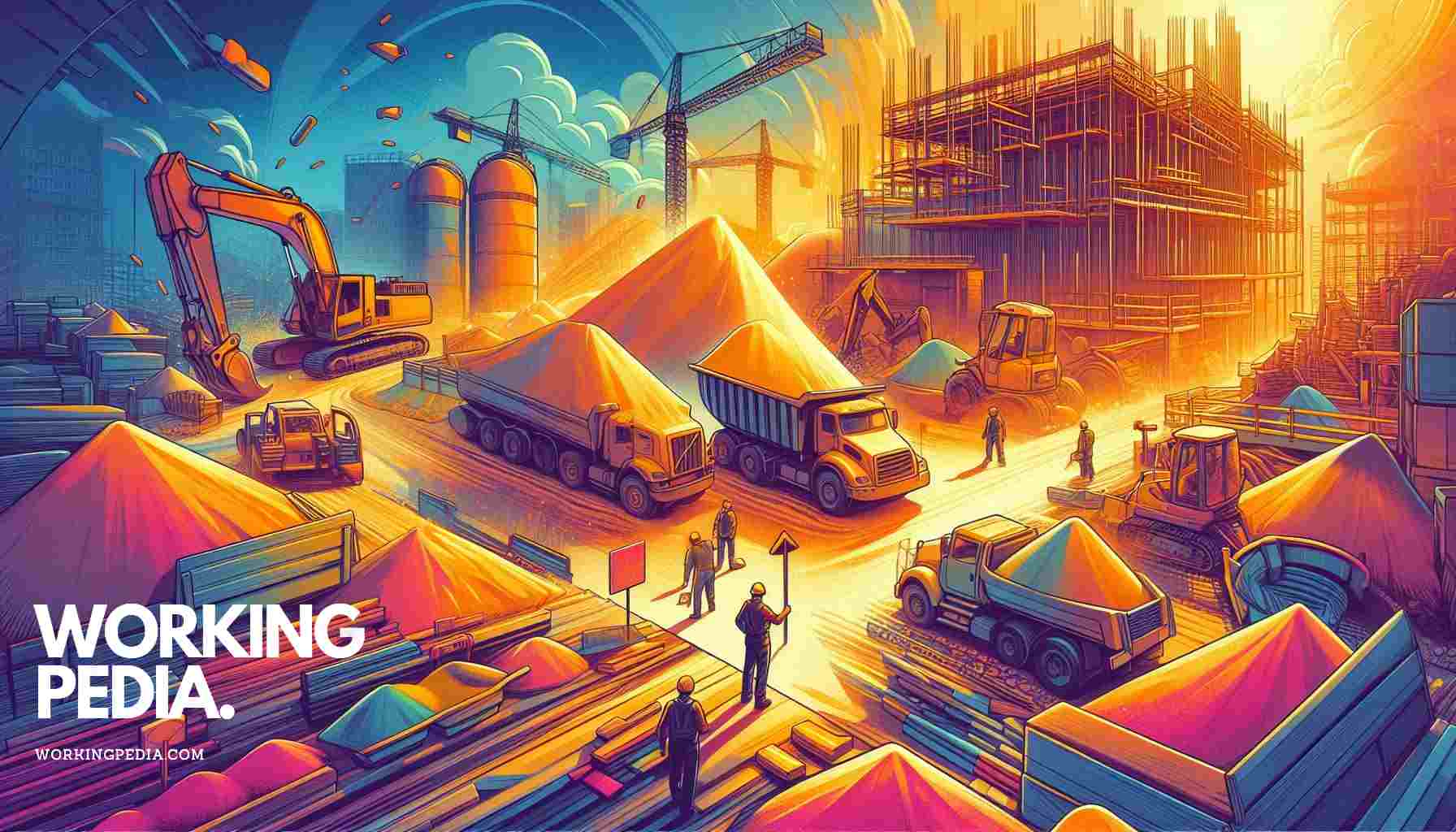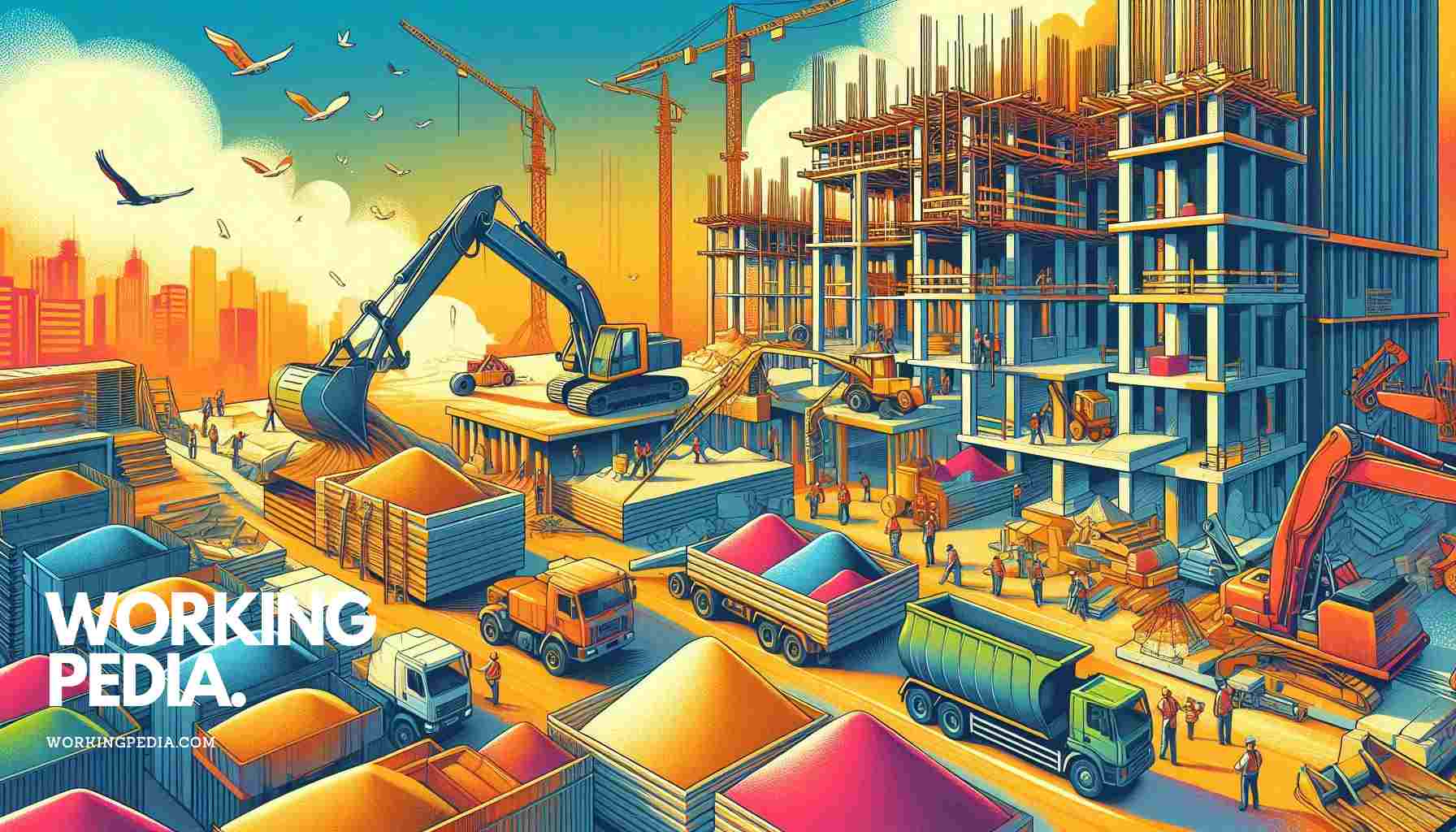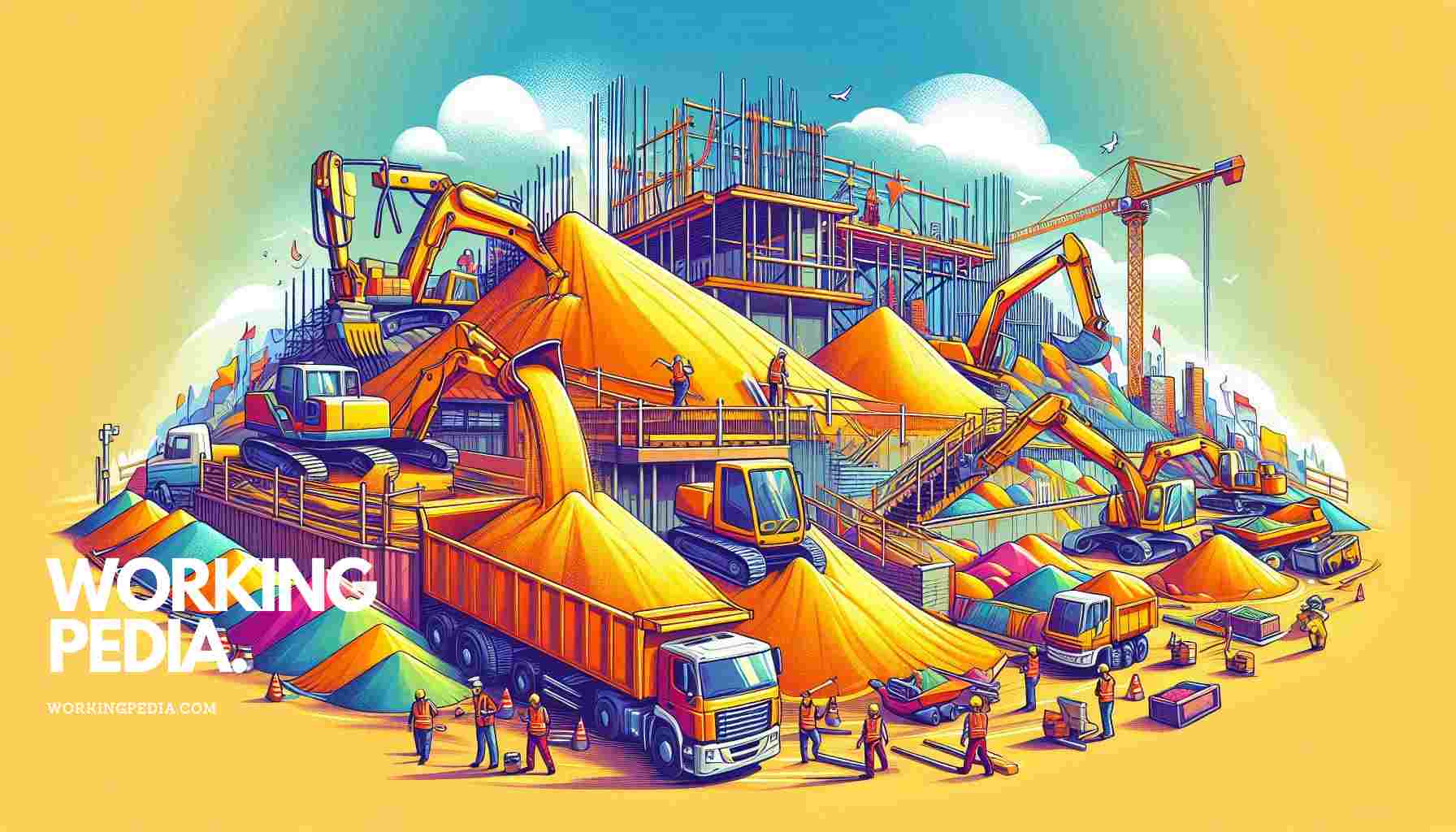Imagine a world without skyscrapers, bridges, or even simple sidewalks. It’s hard to picture, right? That’s because construction sand, the unsung hero of the building industry, plays a crucial role in nearly every construction project. This humble material is literally the foundation upon which our modern world is built!
Construction sand is more than just tiny grains of rock – it’s a versatile and indispensable component in construction. From concrete production to road building, this essential material is the backbone of infrastructure development worldwide. Let’s dive into the world of construction sand and discover why it’s so vital for building projects.
Key Takeaways
- Construction sand is a crucial component in various building projects
- It’s used in concrete, mortar, and asphalt production
- The global demand for construction sand is rapidly increasing
- Sustainable sourcing and alternatives are becoming more important

What Exactly is Construction Sand?
Construction sand, also known as building sand, is a type of sand specifically used in the construction industry. It’s typically composed of small, angular particles of rock or mineral grains, ranging in size from 0.075mm to 4.75mm. This specific composition gives construction sand its unique properties that make it ideal for various building applications.
Unlike the sand you might find at the beach, construction sand is carefully selected and processed to meet specific quality standards. It’s usually sourced from quarries, riverbeds, or marine environments, and then screened and washed to remove impurities. The result? A clean, uniform material that’s ready to be mixed into concrete, mortar, or other construction materials.
Where to Buy Construction Sand
Looking for construction sand? I know it can be a bit tricky if you’re not sure where to start. Whether you’re working on a big project or just need some sand for a small backyard job, it’s important to know where to look and what to consider.
Here are some of the best places to buy construction sand:
- Local Hardware Stores
Your local hardware store is usually a great first stop. Most of them carry basic types of sand like all-purpose or play sand, which can work for smaller construction projects. The cool thing about going local? You can often talk to someone who knows the area and might offer advice on what type of sand will work best for your project. - Landscaping Suppliers
Landscaping supply yards are another solid option. These places usually have a wider variety of sand, from fine masonry sand to coarser construction sand. Plus, they tend to sell in bulk, so if you’re working on something like a driveway or foundation, this is a great way to get a lot of sand for a good price. You can also save on delivery since most local suppliers are happy to bring it straight to your site. - Quarries and Gravel Pits
This might surprise some, but quarries and gravel pits are often the best spots for bulk orders of construction sand. They’re a bit more out-of-the-way, but the cost savings can be huge if you need a large quantity. Many of them also sell directly to the public, and sometimes you can even find specialized sands like river sand, which is perfect for concrete mixes. - Online Marketplaces
Now, if you’re not looking to lug around bags of sand or don’t have a truck to haul bulk, online marketplaces like Amazon or Home Depot’s website can be lifesavers. While you may pay a bit more for shipping or delivery fees, the convenience is hard to beat, especially for smaller projects. Just be sure to double-check the type of sand you’re ordering—some places list different grades, and you’ll want to make sure you’re getting exactly what you need. - Construction Companies
If you’re working on a larger-scale project, consider reaching out to a local construction company. They often have excess materials from job sites and are sometimes willing to sell construction sand at a lower rate. It doesn’t hurt to ask around, and you might score a deal.
Some Final Tips When Buying Sand
- Know the Type of Sand You Need
All sand isn’t created equal! For example, masonry sand is great for making mortar, while coarser sand works well for concrete mixes. If you’re not sure, it’s always a good idea to ask the supplier. - Delivery vs. Pickup
While picking up sand yourself might save on delivery costs, renting a truck or making multiple trips can end up costing more than you think. Check out delivery options—it could save you time and money in the long run.
Wherever you decide to buy your construction sand, take your time to do some homework, compare prices, and don’t hesitate to ask questions. After all, choosing the right sand for the job can make all the difference!

The Importance of Construction Sand in Building Projects
You might be wondering, “Why is sand so important in construction?” Well, let me tell you, it’s not just about building sandcastles! Construction sand plays a critical role in numerous aspects of building projects. Here are some of the key ways it’s used:
1. Concrete Production
One of the primary uses of construction sand is in concrete production. Sand acts as a fine aggregate, filling the spaces between larger aggregates like gravel. This creates a dense, strong material that’s resistant to cracking and weathering. Without sand, concrete wouldn’t have the strength and durability we rely on for our buildings and infrastructure.
2. Mortar and Grout
Sand is also a key ingredient in mortar and grout, which are used to bind bricks, tiles, and other building materials together. The sand in these mixtures provides bulk and helps control shrinkage, ensuring a strong and lasting bond.
3. Landscaping and Drainage
In landscaping, construction sand is used for everything from creating level surfaces for patios to improving soil drainage. Its ability to compact well makes it ideal for these applications.
4. Road Construction
Sand is a crucial component in asphalt mixtures used for road construction. It helps to create a stable, durable surface that can withstand heavy traffic and varying weather conditions.
The Growing Demand for Construction Sand
As our cities grow and infrastructure needs expand, the demand for construction sand has skyrocketed. In fact, after water, sand is the most consumed natural resource on the planet! The United Nations Environment Programme estimates that 40-50 billion tons of sand are used globally each year, with the majority going to the construction industry.
This increasing demand has led to some unexpected consequences. In some regions, the extraction of sand has outpaced natural replenishment, leading to environmental concerns. Beaches are eroding, riverbeds are being depleted, and marine ecosystems are being disrupted. It’s a classic case of supply struggling to keep up with demand.
But it’s not all doom and gloom! The construction industry is becoming increasingly aware of these issues and is looking for sustainable solutions. From recycling concrete to developing alternative materials, there’s a lot of innovation happening in this space.
Quality Matters: Choosing the Right Sand for Your Project
Not all sand is created equal, and choosing the right type for your specific project is crucial. The quality of sand can significantly impact the strength, durability, and overall performance of the final product. Here are some factors to consider when selecting construction sand:
1. Particle Size and Shape
The size and shape of sand particles can affect how well they bond with other materials. Angular particles typically create stronger bonds than rounded ones. The ideal particle size distribution depends on the specific application.
2. Cleanliness
Sand should be free from impurities like clay, silt, or organic matter. These contaminants can weaken the final product and cause issues like shrinkage or cracking.
3. Chemical Composition
The mineral content of sand can affect its reactivity with cement and other materials. For example, silica sand is often preferred for concrete production due to its chemical stability.
4. Moisture Content
The amount of moisture in sand can impact how it mixes with other materials. Too much moisture can lead to issues with workability and strength.
Choosing the right sand for your project might seem like a daunting task, but it’s essential for ensuring the quality and longevity of your construction. Don’t hesitate to consult with experts or conduct tests to ensure you’re using the best material for your specific needs.
As we continue to explore the world of construction sand, we’ll delve into some of the innovative alternatives and sustainable practices that are shaping the future of the construction industry…

Innovative Alternatives and Sustainable Practices
As we face the challenges of sand scarcity and environmental concerns, the construction industry is getting creative. There’s a whole world of innovative alternatives and sustainable practices emerging. Let’s take a look at some of these exciting developments!
Recycled Materials
One man’s trash is another man’s treasure, right? Well, in this case, it might just be the future of construction. Recycled materials are making a big splash in the industry. We’re talking about crushed glass, recycled plastic, and even ground-up old concrete. These materials can often replace a portion of the sand in concrete mixtures, reducing the demand for fresh sand.
I once visited a construction site where they were using recycled glass in their concrete mix. It was fascinating to see how something that would’ve ended up in a landfill was instead being used to build a sturdy office building!
Manufactured Sand
If we can’t find enough natural sand, why not make our own? Manufactured sand, also known as M-sand, is produced by crushing rock or granite into sand-sized particles. It’s becoming increasingly popular, especially in regions where natural sand is scarce. The best part? It often performs just as well as natural sand in construction applications.
Alternative Building Materials
Some innovators are taking things a step further and developing entirely new building materials that use little to no sand. From hempcrete (made from hemp fibers and lime) to mycelium (fungus-based) materials, these alternatives are pushing the boundaries of what’s possible in construction.
I recently chatted with an architect who’s experimenting with bamboo-based construction materials. She’s incredibly excited about the potential to create sustainable, sand-free buildings. It’s mind-blowing to think about how our cities might look in the future!
The Future of Construction Sand
So, what does the future hold for construction sand? Well, it’s likely to be a mix of traditional and innovative approaches. Here are some trends to watch:
- Increased regulation of sand mining to protect ecosystems
- More widespread adoption of recycled and alternative materials
- Development of new technologies for sand production and processing
- Greater emphasis on sustainable construction practices
- Potential for sand “banks” to manage this valuable resource
It’s an exciting time to be in the construction industry! The challenges we face with sand scarcity are driving innovation and pushing us to think outside the box. Who knows? The next big breakthrough in construction materials might be just around the corner.
As we wrap up our deep dive into the world of construction sand, it’s clear that this humble material plays a crucial role in shaping our built environment. From the foundations of our homes to the roads we drive on, sand is quite literally everywhere. While we face challenges in sourcing this vital resource sustainably, the future looks bright with innovative solutions on the horizon.
So next time you pass by a construction site or walk on a concrete sidewalk, take a moment to appreciate the tiny grains of sand that make it all possible. It’s a small reminder of the incredible ingenuity and resourcefulness of human engineering. Who knew that something as simple as sand could be so fascinating?
Frequently Asked Questions
1. What’s the difference between construction sand and regular beach sand?
Construction sand is specifically processed for building purposes, with controlled grain size and shape. It’s typically more angular and has fewer impurities than beach sand. Beach sand, on the other hand, is often too fine and contains salt, which can weaken concrete. Using beach sand in construction could lead to structural issues down the line.
2. How much sand is typically used in concrete?
The amount of sand in concrete can vary, but a common mix ratio is 1:2:3 (cement:sand:gravel). This means that for every one part of cement, you’d use two parts sand and three parts gravel. In a cubic yard of concrete, you might find about 1,000 pounds of sand. However, the exact amount can vary based on the specific mix design and project requirements.
3. Is there really a global sand shortage?
Yes, in many parts of the world, there is a growing shortage of suitable construction sand. While desert sand is plentiful, its grains are too smooth and fine for most construction purposes. The type of sand needed for construction – typically river sand or crushed rock – is becoming scarce in many regions due to over-extraction. This scarcity has led to increased prices and even illegal sand mining in some areas.
4. Can you use desert sand for construction?
Generally, desert sand is not suitable for most construction purposes. The grains are too fine and smooth, shaped by wind rather than water. This makes it difficult for desert sand to bind well in concrete or other construction materials. However, researchers are working on ways to treat desert sand or mix it with other materials to make it usable in construction, which could help address sand shortages in some regions.
5. How is construction sand mined?
Construction sand is typically mined through dredging of riverbeds or seafloors, or through quarrying. In river dredging, boats use large scoops or suction pumps to extract sand from the riverbed. Quarrying involves blasting rock and then crushing it to the desired size. After extraction, the sand is usually washed and screened to remove impurities and ensure the right grain size distribution.
6. What are the environmental impacts of sand mining?
Sand mining can have significant environmental impacts. These include:
- Erosion of riverbanks and coastlines
- Destruction of habitats for fish and other aquatic life
- Increased water turbidity, affecting aquatic ecosystems
- Lowering of water tables
- Potential for increased flooding due to changes in river dynamics
Responsible mining practices and regulations are crucial to minimize these impacts.
7. How does the quality of sand affect construction?
The quality of sand can significantly impact the strength, durability, and workability of construction materials like concrete. High-quality sand with the right grain size, shape, and composition will result in stronger, more durable concrete. Poor quality sand, or sand with impurities, can lead to weaker structures, increased cracking, and potential structural failures. That’s why it’s so important to choose the right type of sand for each specific construction application.
8. What are some alternatives to natural sand in construction?
There are several alternatives to natural sand being explored in the construction industry:
- Manufactured sand (M-sand): Crushed rock designed to match the properties of natural sand
- Recycled concrete aggregate: Crushed concrete from demolished structures
- Fly ash: A byproduct of coal combustion that can partially replace sand in concrete
- Bottom ash: Another coal combustion byproduct with potential uses in construction
- Foundry sand: Recycled sand from metal casting processes
- Crushed glass: Recycled glass ground to sand-like consistency
Each of these alternatives has its own pros and cons, and their suitability depends on the specific application.
9. How is the construction industry addressing the sand shortage?
The construction industry is addressing the sand shortage through various strategies:
- Developing and adopting alternative materials, like those mentioned above
- Improving sand mining techniques to be more efficient and less environmentally damaging
- Recycling construction waste to recover usable sand and aggregates
- Researching new concrete mix designs that require less sand
- Exploring the use of 3D printing in construction, which can reduce material waste
- Advocating for better regulations and sustainable practices in sand mining
It’s a complex challenge that requires collaboration across the industry, government, and research institutions.
10. Can I use any type of sand for my DIY home project?
For DIY home projects, it’s important to use the right type of sand for the job. All-purpose sand from a home improvement store might work for some projects, but for anything structural, you’ll want to use proper construction or masonry sand. For concrete, use concrete sand, which has a specific grain size distribution. For mortar or laying pavers, use masonry sand. If you’re unsure, it’s always best to consult with a professional or the staff at your local hardware store. Using the wrong type of sand could lead to poor results or even safety issues in your project.
MUST SEE Related Construction
Construction www.workingpedia.com/category/contstruction






